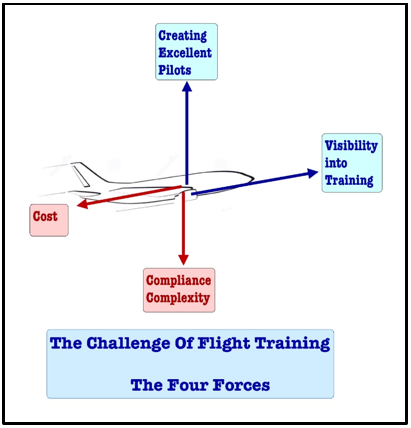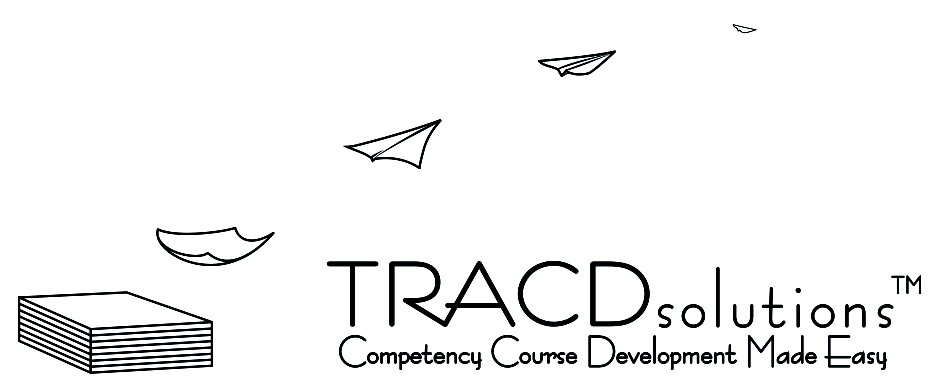The Four Forces of Training – Part 3 - Maximising the Force for Creating Excellent Pilots
So far I have written about two of the 4 great forces at work within any training environment – whether you are a 141 flight school or a 142 Integrated training organisation.
The great challenge of flight training is not to balance the four forces (there is no profit in that), but through management actions to set the two forces of “Visibility” and “Creating Excellent Pilots” to their maximum and to minimize the effects of “Cost” and “Compliance Complexity”. This will provide you with acceleration and growth in your training.
I now want to focus on the vital aspect of maximising the force for Creating Excellent Pilots in the training process. This is the part that excites me most. We all want to develop pilots who are professional, knowledgeable, competent, safe and confident in their aviation activities. How can we create excellent pilots?
![]() Learning: You need two things to produce excellent pilots – Great instructors and a great course. CASA requires “detailed lesson plans” to provide standardized details about the teaching content, technical details, technique and standards. All great courses provide this detail and don’t expect instructors to “make it up”. This also helps to make great instructors! Does your course specify all the teaching content…or is it just in your instructors’ heads?
Learning: You need two things to produce excellent pilots – Great instructors and a great course. CASA requires “detailed lesson plans” to provide standardized details about the teaching content, technical details, technique and standards. All great courses provide this detail and don’t expect instructors to “make it up”. This also helps to make great instructors! Does your course specify all the teaching content…or is it just in your instructors’ heads?
![]() Communication: Excellent pilots are always learning and are motivated to learn. Your training environment should have the tools for students to communicate with instructors and instructors with students from within the training course to keep students focussed on task. Student study guidance built into the course (it’s not optional) and an easy in-built messaging system that keeps bringing students back to their lessons will be a big factor in effective communication. Students must be able to log on and see previous lesson records (automatically provided to them without instructors needing to scan, copy and send), their private study guidance, messages, lesson details and future lessons as they progress through their course. This is motivational and keeps students wanting to fly.
Communication: Excellent pilots are always learning and are motivated to learn. Your training environment should have the tools for students to communicate with instructors and instructors with students from within the training course to keep students focussed on task. Student study guidance built into the course (it’s not optional) and an easy in-built messaging system that keeps bringing students back to their lessons will be a big factor in effective communication. Students must be able to log on and see previous lesson records (automatically provided to them without instructors needing to scan, copy and send), their private study guidance, messages, lesson details and future lessons as they progress through their course. This is motivational and keeps students wanting to fly.
![]() Standardization: Excellent pilots are created when they keep getting the same content, message or instructions about a course component. There is nothing more depressing that hearing a student say “But, Frank (another instructor) told me to do it this other way.” This simply confuses the students, produces poorer outcomes or simply results in the student “dropping out” because of the mixed messages. Great lesson plans provide all the required technique, detail and information to maintain a high level of standardization for how your training organisation likes to teach.
Standardization: Excellent pilots are created when they keep getting the same content, message or instructions about a course component. There is nothing more depressing that hearing a student say “But, Frank (another instructor) told me to do it this other way.” This simply confuses the students, produces poorer outcomes or simply results in the student “dropping out” because of the mixed messages. Great lesson plans provide all the required technique, detail and information to maintain a high level of standardization for how your training organisation likes to teach.
![]() Documented: Solo lessons are a vital part of training. Students have the opportunity to practice all aspects of their training. But they need to know what they must do – and this is much more than saying “You’re off to practice stalls and steep turns next”. A great course provides comprehensive written notes for solo training (and allows for the instructor to easily modify the solo training) so that the student can read, study and prepares exactly for the flight before they come out to the airfield.
Documented: Solo lessons are a vital part of training. Students have the opportunity to practice all aspects of their training. But they need to know what they must do – and this is much more than saying “You’re off to practice stalls and steep turns next”. A great course provides comprehensive written notes for solo training (and allows for the instructor to easily modify the solo training) so that the student can read, study and prepares exactly for the flight before they come out to the airfield.
![]() Diagrams: A picture paints a thousand words – but if instructor John has different pictures to that of Mary then the student might get confused a thousand times quicker. Its part of standardization to capture the best teaching diagrams and reference material and attach it to the course so that every instructor has access to the best material. Your training course must be able to capture this teaching resources and be able to easily add more or swap out poor performing resources. Making these resources available “on the go” through mobile technology is vital.
Diagrams: A picture paints a thousand words – but if instructor John has different pictures to that of Mary then the student might get confused a thousand times quicker. Its part of standardization to capture the best teaching diagrams and reference material and attach it to the course so that every instructor has access to the best material. Your training course must be able to capture this teaching resources and be able to easily add more or swap out poor performing resources. Making these resources available “on the go” through mobile technology is vital.
![]() Lessons: Training is dynamic and time is precious. You don’t want instructors wasting time printing off lesson plans or copying records. A fully digital and mobile solution using current iPad/Android apps and computer access will allow instructors to deliver briefings and flight lessons “on the go” with all the resources “at their finger tips”. They can capture evidence and record performance whilst in the field to give them extra time with their students. Use technology to enhance your training.
Lessons: Training is dynamic and time is precious. You don’t want instructors wasting time printing off lesson plans or copying records. A fully digital and mobile solution using current iPad/Android apps and computer access will allow instructors to deliver briefings and flight lessons “on the go” with all the resources “at their finger tips”. They can capture evidence and record performance whilst in the field to give them extra time with their students. Use technology to enhance your training.
![]() Modify: Training must adapt – to the weather, to student achievement and to student rate of learning. The training course must be easily modified “on the fly” for individual students based on their individual needs. Items not taught, not assessed or not competent must be easily captured and then easily added back into subsequent lesson plans and lesson records. The only effective way to do this is via a fully digital lesson and record system that automatically keeps track of everything and allows you to build a lesson from the standard course and add and sequence “not yet done” items into the lesson and subsequent record. This must be done at a performance criteria level to achieve compliance and effective training.
Modify: Training must adapt – to the weather, to student achievement and to student rate of learning. The training course must be easily modified “on the fly” for individual students based on their individual needs. Items not taught, not assessed or not competent must be easily captured and then easily added back into subsequent lesson plans and lesson records. The only effective way to do this is via a fully digital lesson and record system that automatically keeps track of everything and allows you to build a lesson from the standard course and add and sequence “not yet done” items into the lesson and subsequent record. This must be done at a performance criteria level to achieve compliance and effective training.
What aspects of creating excellent pilots are most significant for you in your training? What areas do you need to work on? If you would like to see how TRACDsolutions maximizes the task of creating excellent pilots, click here. We can provide you with a solution that will minimize your costs and compliance issues and maximize your profits and results, just head over here or give me a call. In the next articles I will cover the last force – “Costs” – and look at how that can be minimized.
Hadyn Siggins.

